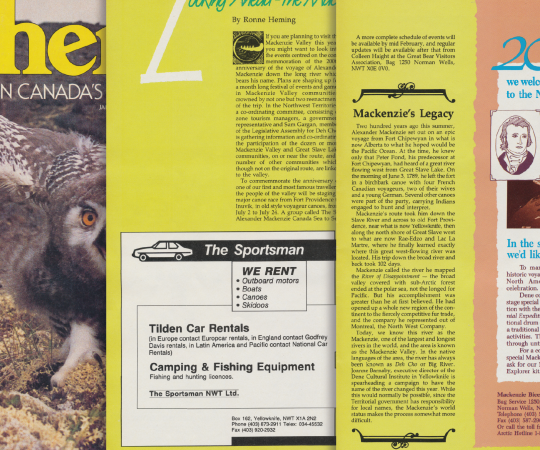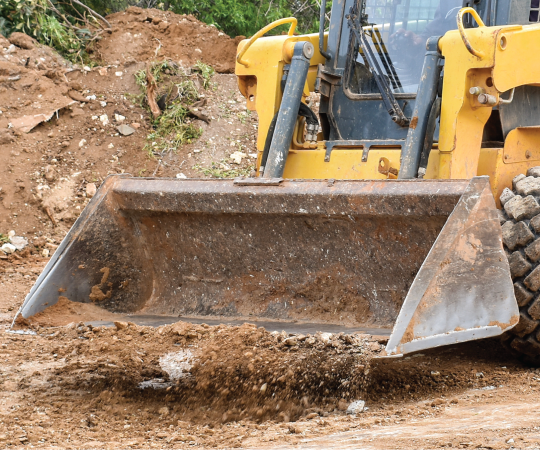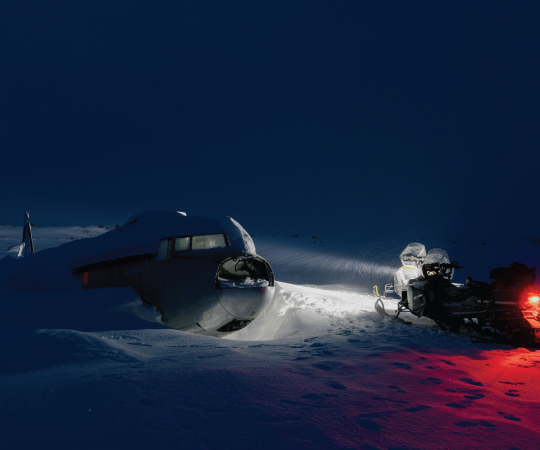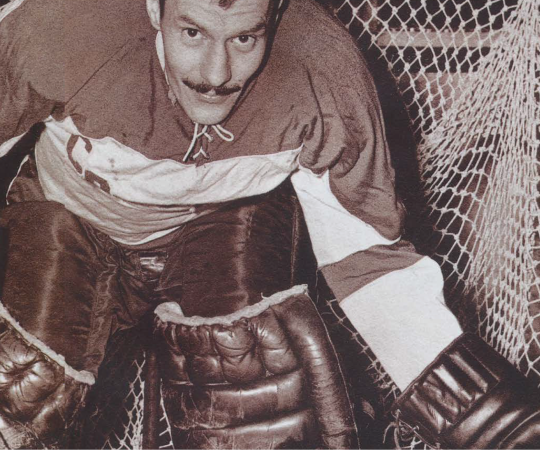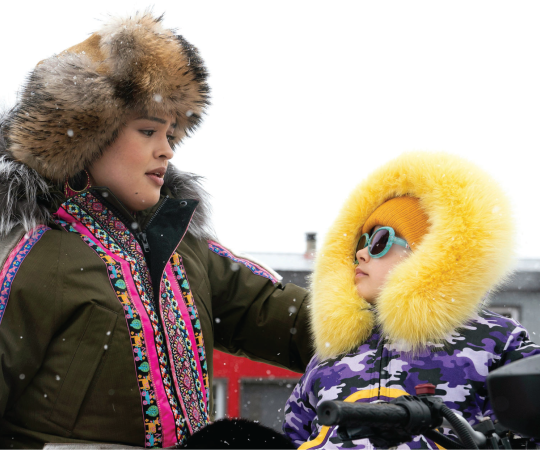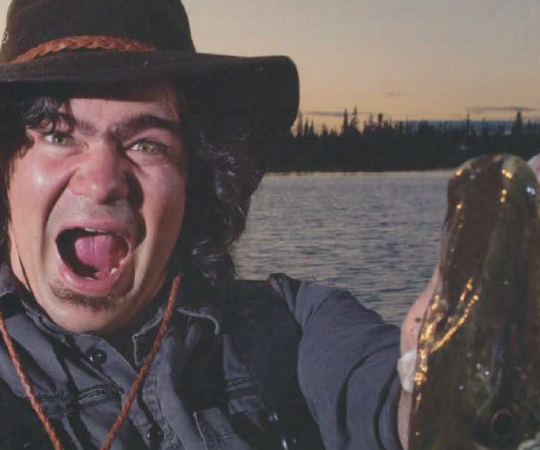It’s a cold February morning, and Yellowknife Bay is alive with activity. Skidoos rip across the frozen surface of Great Slave Lake, off Old Town and Latham Island. Pedestrians in snowsuits waddle down ice roads, and cross-country skiers glide off toward the horizon. In the distance, a crew is hard at work building the giant annual Snowcastle, molding walls and arches out of snow.
Nicole Goodman sits in the living room of her houseboat by Jolliffe Island’s southwest shore and surveys it all through a frost-covered window. She’s snuggled under a blanket on the couch, a wood stove humming away a few feet in front of her and a steaming mug of tea resting on the coffee table. Warm and cozy, it’s a great little observatory for people-watching.
“Every houseboater I know has a pair of binoculars for watching people,” she chuckles.
Goodman has been a “houseboater” for three years, living with her husband Brian Weadick in a two-storey brown building on massive steel pontoons. It’s anchored in place beside Jolliffe in the summer, and frozen there in the winter. One of the older houseboats in ‘Houseboat Bay,’ it still bears its original name: the Zebulon Pike.
Admittedly, the couple doesn’t know what it means. But they like it. “And one does not simply rename a houseboat, so the Zebulon Pike it is,” says Goodman. The name even appears as her address on her driver’s license.
For Goodman, life on the Zebulon Pike is busy. There are always chores to do, errands to run, things to fix. It’s a lot of work to keep the house’s offgrid systems—a diesel generator for electricity, propane appliances, water pumped in from the lake—running. Daily canoe commutes to land during the summer can quite literally go sideways if it’s windy. Not to mention the perils of trying to cross the bay during the shoulder seasons, which can feel death-defying at times. Sometimes, living on a houseboat just seems like one constant exercise in overcoming obstacles.
Yet that’s precisely what makes it so extraordinary, Goodman says. It toughens you up, makes you more adaptable and self-sufficient. Plus, the harder you work, the sweeter the fruits of your labour—and when you can finally kick back and wrap yourself in the tranquility of the lake, they taste pretty darn sweet.
“It’s peaceful,” Goodman says. “It’s calm. It’s beautiful.”
--
Type Yellowknife into Google, and the houseboats are likely one of the first images to pop up. They’re a major attraction for tourists, a muse for photographers and artists, and a source of casual curiosity for local residents. They were even the basis of a short-lived and controversial reality series, Ice Lake Rebels. Slowly but surely, these unconventional abodes made their way into the heart of the city’s identity.
The exact beginnings of the houseboats on Yellowknife Bay can be hard to pin down. In her 2012 book Old Town, author Fran Hurcomb suggests it can be traced back to the early 1980s, when Old Town residents Gary Vaillancourt and John Alexander used old barrel barges and salvaged wood from torn-down Giant Mine dormitories to build floating homes. The men had grown frustrated with rising real estate prices and yearned for a space beyond an ever-expanding net of city regulations. With rebellious gumption, they launched their barges off the shore and moored them next to Jolliffe Island—technically off municipal lands—where they were shielded from the wind and could live year-round.
From there, the community quickly grew. Despite a contentious relationship with city council that marred the first decade (a can of worms we won’t open here, but essentially came down to taxes and control), another seven houseboats were on the water by 1988. A couple more joined each year after that—and around Jolliffe at first. But when space became hard to find, houseboaters looked to two nearby rocky outcrops known colloquially as “Dog Island One” and “Dog Island Two,” because mushers used to keep dog teams there in the summer.

Today, there are 30 or so houseboats that make up Yellowknife Bay’s floating community. Some are retired marine vessels, but most are akin to tiny houses on metal or plastic pontoons. Heat and power are derived from solar panels, small wind turbines, diesel generators, wood stoves, or propane tanks. Water is sourced from the lake below. The homes can be surprisingly spacious and modern, or compact and more rustic. When it comes to houseboats, there’s no one-size-fits-all description.
The same can be said for houseboaters themselves. A few have been on the bay for nearly three decades—and will be there for several more. Others are merely stopping by for a change of pace before settling down somewhere else. There are mine workers, tradespeople, artists, civil servants. It’s a decidedly eclectic bunch.
Between Jolliffe and Dog Island One, filmmakers Courtney McKiel and Martin Rehak live aboard the brightly coloured Empress of Yellowknife.
“Yeah, it’s really high on itself,” McKiel says, playfully mocking the name of her home with a grin. To the Empress’s credit, it’s probably one of the bay’s most photographed houseboats, with its vibrant orange walls and blue frame attracting the attention of anyone with a camera lens.
“We’ve got a collection of paintings and pictures of it that friends have given to us,” McKiel says. “We’ve got this shrine to our house, in our house, which is kind of funny.”
McKiel and Rehak’s houseboat journeys began on a big barge beside Jolliffe Island, where they each rented apartments for a time. The units were pretty tight; Rehak’s was so small, it was known as “The Hobbit Hole.” Nonetheless, they both formed many close friendships with other tenants and even held the occasional garden party in the small greenhouse on the deck. The couple loved the experience so much, they decided to buy the Empress when it went up for sale three years ago.
As artists, McKiel (who runs the non-profit Western Arctic Moving Pictures) and Rehak are used to taking risks if it means finding unique opportunities to feed their souls and fulfill a sense of purpose. Living on a houseboat, they figure, is simply an extension of that ethos.
“It’s the same way that somebody would pursue gig work and the inconsistency of work,” Rehak says. “Why would someone find that appealing? Or why would you find a houseboat appealing, right? It’s more exciting and interesting. It just takes a certain kind of mindset.”
Over near Dog Island Two, Darcy Bourassa and Kate Bolivar reside in the simply named Houseboat 28 with their husky, Chicha.
“This is the suburbs,” Bourassa jokes, and the analogy holds up. There’s a little more space here, and the boats aren’t parked as close together as they are near Jolliffe (or “the downtown core”).
Both Bourassa and Bolivar are lifelong Yellowknifers, but neither had much of a connection to the houseboat community growing up. It was only when they were adults that they became drawn to the bay for the lifestyle.
For example, Bolivar says she likes to travel, and the houseboat makes that easier to do. “It’s that idea of being able to leave your home by itself and not be spending a bunch
of money on utilities and stuff. Darcy and I technically could turn all of our systems off and just leave our house for a year if we really wanted to. And I like not having to commit to a mortgage, because that commitment makes me feel a bit stressed.”
The market for buying a houseboat is rather informal. It’s done friend-to-friend or through someone who knows someone. Sales are quick and cheap compared to those on land. For instance, Goodman and Weadick made a one-time payment of $190,000 to buy the Zebulon Pike. “We’re certainly not viewing it as an investment property…it’s not going to last forever,” Goodman says. “But if eventually something goes wrong with it, at least we’re not on the hook for a $600,000 mortgage.”
It’s the same for Bolivar and Bourassa. They’re happy to take on the risk of buying a home that can’t be insured or financed, because it’s more flexible and affordable. Since it’s offgrid, they also don’t have to worry about an endless stack of bills.
That being said, Houseboat 28 is definitely on the swankier end of things. “It’s super liveable and comfortable,” Bourassa says almost sheepishly. It’s a roomy 1,100 square-feet, with an extra sleeping loft on top of a master bedroom, a full-service kitchen, and flat-screen TV in front of a large sectional in the living room. The bathroom even has a tub. Considering some houseboats don’t have running water, it’s practically the lap of luxury.
Pilot Shad McLeod’s home probably fits in better with stereotypical ideas of what constitutes a houseboat: a modest 40-foot-long by 10-foot-wide steel container on fibreglass pontoons by Dog Island One. He’s crowned it The Rocking Houseboat, out of both love and frustration.
“I gave it that name after a couple of sleepless nights of feeling like I was on the Atlantic,” McLeod laughs. When he bought it almost four years ago, it was attached to three anchors and got easily broadsided when south winds blew in. “Things would be flying off the shelves. My dog would just be looking at me like, ‘This is ridiculous. We’ve made a huge mistake.’”
To make it more stable, McLeod has since shifted to a single-anchor system so the house can swing and pivot with the wind. It’s been a drastic improvement, he says, and black lab Naya agrees.
On The Rocking Houseboat, McLeod enjoys a very simple set up—a small seating area, a Murphy bed that folds into the wall, a composting toilet in the bathroom. He’s done away with any frills when it comes to electricity. There’s no toaster or TV because it draws more power than his solar panels and tiny generator can provide. In the winter, he turns off his propane fridge and rotates ice blocks he’s chiseled to keep food cool.
For McLeod, the importance of cutting down on energy consumption is twofold. One, it lets him reduce his personal carbon footprint. Two, it lends itself to focusing on what he believes the houseboat life is really all about: being connected to your environment and the natural world around you.
“If I had a stressful day or whatever, coming down on the water is so grounding and it’s so calming, that by the time I jump in my boat and I’m paddling across and I get home, everything that was weighing me down previously just melts away,” McLeod says. “That’s pretty incredible. It’s this wonderful transition where the pace just slows down.”
Everything about life on the bay changes with the seasons and weather. Summer brings a short canoe or motorboat commute with every trip into town. If it’s windy, it means trying to paddle your way home in two-and-a-half-foot swells with whitecaps. In the winter, there’s the ease of being able to drive your car onto the lake and parking right outside your house—albeit with the lurking threat of plunging temperatures that can send your home into a deep freeze.
Houseboaters are at the mercy of whatever Mother Nature has in store for them. “The highs are high, and the lows can be really low,” Bourassa says.
He knows what he’s talking about. Before he and Bolivar bought Houseboat 28, he lived next door for eight years in a tiny wooden house on plastic barrels that he had bought off friends. “That one is just a topper,” he says. “It just bobs around.” Their current house presents less problems because it’s sturdier with more mass to keep it in place, but it certainly hasn’t been without difficulties.
“In the first two weeks that we lived here, there was a crazy windstorm,” Bourassa remembers. “The entire time I lived next to this place, it had never moved.” Then, one morning, they woke up in a different spot. “Now, I’m trying to get us back into place before freeze-up and it’s late October.”
Spring break-up and fall freeze-up, which usually last a couple of weeks each, are crucial times on the bay. Not only do you have to make sure your houseboat stays put and remains level as the ice around it shifts or settles, but getting to land safely can get dicey. The tried-and-true method is to drag a canoe along the thinning ice beside you as you walk so you can jump in if there’s a sudden break.
The execution isn’t always perfect.
“I’ve scratched the shit out of my hands and forearms trying to get onto the ice with the canoe, going to my house,” McKiel remembers. “That was rough…but you learn fast what to do and what not to do.”
Houseboaters form a unique relationship with the ice they live on, an understanding that the average land-dweller typically doesn’t have. They know where not to walk at certain times of the year. They learn to read the ice’s colours and shapes as it melts, how it fills with water and candles as it drains, to decipher what is safe and what isn’t.
“It’s also very beautiful as the ice changes; you get really good photos of it,” Rehak says. “I can only imagine if I lived on land and didn’t have this experience. It would just be frozen and not frozen, as opposed to having all of these little nuanced periods of ice throughout the year.”
But the bay is strange that way, always giving you pause to appreciate the smaller things in life. Even when a giant ice pan threatens to push every last houseboat off their anchors, a mad dash to chip away at it can become a triumph.
That’s exactly what happened last spring. As a sheet of ice loosened by the spring melt drifted towards their homes, a small team of Dog Island Two houseboaters (including Bolivar and Bourassa) assembled in canoes and motorboats. They whacked off chunks of the ice with hockey sticks, paddles, and shovels, and used the noses of their boats to maneuver it away from the houses. It was a tough fight—but disaster was averted.
“We finally got out and around, and you can see it just leave the bay,” Bourassa says excitedly. “We all just went and had a beer with our neighbours, just exhausted.
“It was 10 hours of battling, then it was sweet. Now it’s summer and we don’t have to worry about that.”
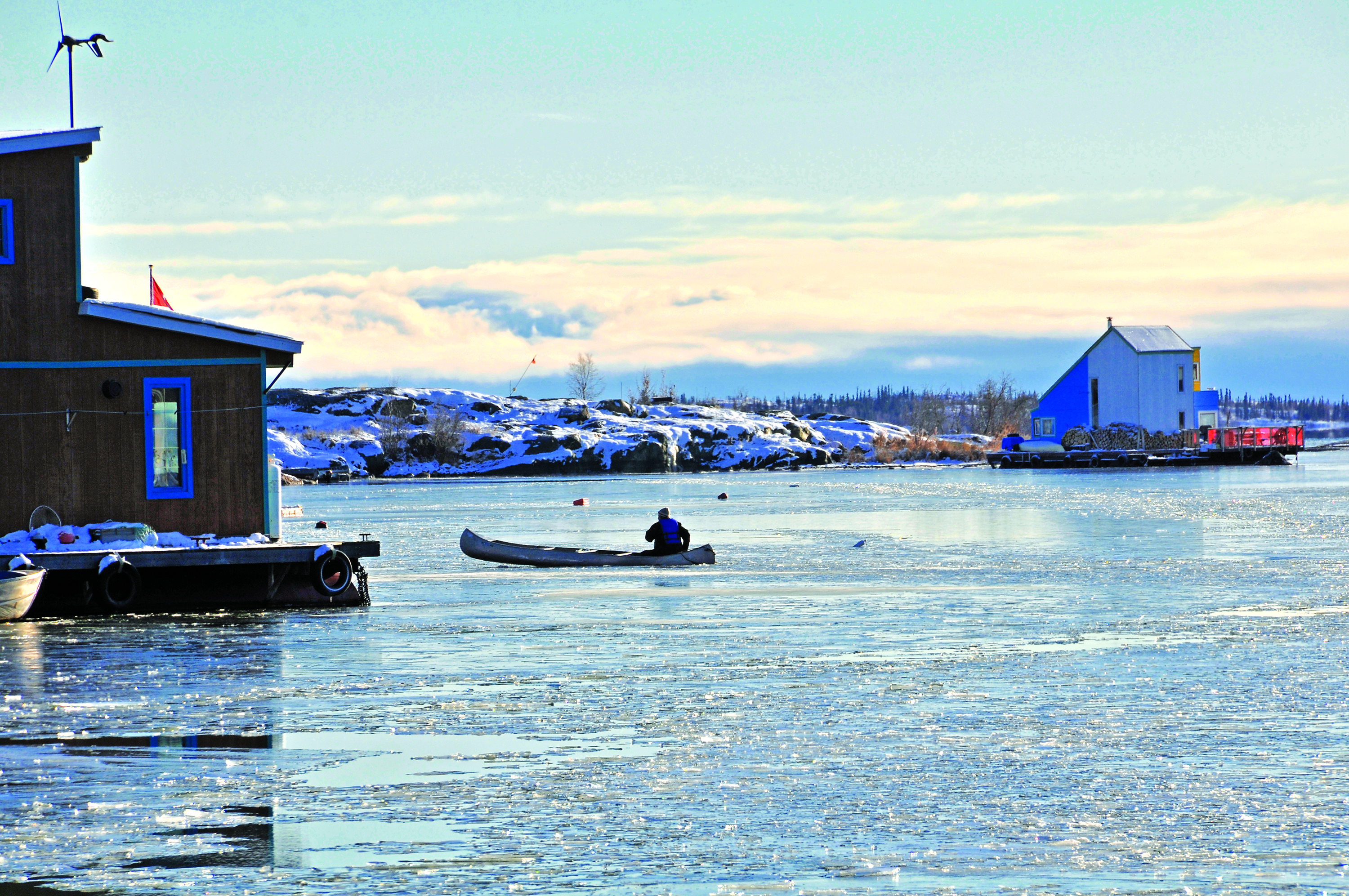
---
Last August, Goodman and Weadick hiked to the top of Jolliffe Island with a handful of family and friends. They set up benches in a rocky clearing and lined the makeshift aisle with potted flowers. There, the couple was married under the midnight sun. After a barbecue and several rounds of champagne to ring in the nuptials, the party returned to the newly-weds’ houseboat and continued into the wee hours of the morning.
The Zebulon Pike was the centre of the houseboat universe that night. At least 40 canoes, kayaks, paddleboards, and motorboats were tied there with all the guests that paddled up. Out front, there were two floating saunas and a water trampoline, brought over by fellow houseboaters to add to the merriment.
“We had it perfectly set up so that you could leap out of the sauna, onto the trampoline, and into the water,” Goodman says. “What I loved so much about that was that it’s water. Everything moves. The next morning, all those people just chugged up in motorboats in various states of hangover and grabbed their sauna or their trampoline and towed it home.
“It was the best party ever.”
Yellowknife Bay is a happening place. There’s always an impromptu bonfire or a casual round of porch beers to attend. A group of volunteers make a hockey rink near Jolliffe every year where they hold regular shinny games—and even the odd curling bonspiel. In the spring, the massive Snowcastle hosts a solid line-up of activities and local performances and becomes the busiest place in Yellowknife some weekends. It’s an incredibly social community, bound together by common experiences and a thirst for adventure in the everyday. And very early in the morning, when the water is glassy, it’s also a place of incredible serenity when everything is quiet and still.
The pull of the lake is powerful, Goodman says. It works its way into your bones, and you truly miss it when you aren’t there.
“Everybody I’ve talked to who lives here, we all sort of agree: no matter how shitty of a day you may have had, as soon as you get in the canoe to go home, you’re like, ‘Wow, this is so beautiful, and so calm.’”
And that’s why pleasures outweigh perils when it comes to life on Yellowknife Bay.


